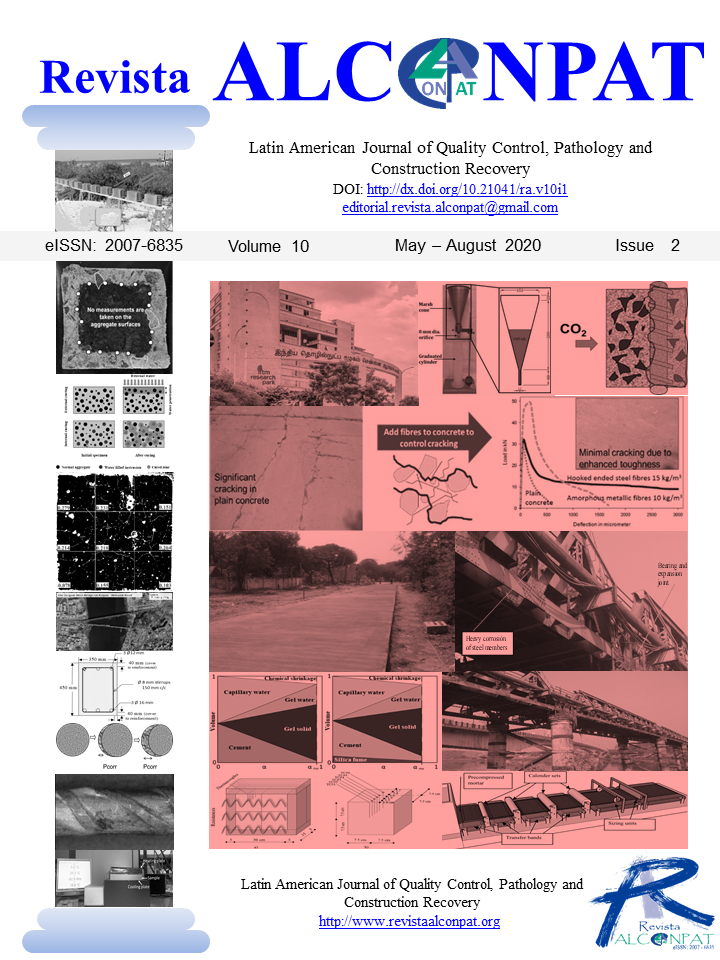A numerical approach for evaluating residual capacity of fire damaged concrete members
DOI:
https://doi.org/10.21041/ra.v10i2.483Keywords:
reinforced concrete members, fire damage, cooling phase, post-fire residual capacityAbstract
This paper presents an approach to evaluate residual capacity of fire-damaged concrete structures. The approach involves capturing response in three stages; namely, structural response at ambient conditions (prior to fire exposure), thermo-mechanical response during fire exposure, and post-fire residual response after cooling down of the structural member. The proposed approach is implemented in a comprehensive numerical model developed in the finite element computer program ABAQUS for specifically evaluating residual capacity of an RC beam after exposure to different fire scenarios. Predictions from the numerical model are utilized to highlight importance of each stage of analysis in evaluating realistic residual capacity of fire damaged concrete members.
Downloads
References
ABAQUS (2012), ABAQUS Version 6.12 Documentation. Dassault Systemes Simulia Corp., Providence, RI. URL: http://130.149.89.49:2080/v6.12/index.html
American Concrete Institute (ACI) (2008). ACI 318-08: Building code requirements for reinforced concrete. Vol. 552. American Concrete Institute. 465 pp. Farmington Hills, MI.
ASTM International (2018). E119-18 Standard Test Methods for Fire Tests of Building Construction and Materials. West Conshohocken, PA; ASTM International. doi: https://doi.org/10.1520/E0119-18
Bai, L., Wang, Z. (2011). Residual Bearing Capacity of Reinforced Concrete Member after Exposure to High Temperature. Advanced Materials Research. 368–373:577–81. https://doi:10.4028/www.scientific.net/AMR.368-373.577.
Beitel J., Iwankiw N. (2005). Historical Survey of Multistory Building Collapses Due to Fire. Fire Protection Engineering. 3rd Quart. issue 27: 42-49.
European Committee for Standardization (CEN) (2004a). EN 1991-1-2, Eurocode 1: Actions on structures. Part 1-2: General actions - Actions on structures exposed to fire. Brussels, Belgium.
European Committee for Standardization (CEN) (2004b). EN 1992-1-1, Eurocode 2: Design of concrete structures. Part 1-1: General rules and rules for buildings. Brussels, Belgium; 2004.
European Committee for Standardization (CEN) (2004c). EN 1992-1-2, Eurocode 2: Design of Concrete Structures. Part 1–2: General Rules – Structural Fire Design, p. 97. Brussels, Belgium.
European Committee for Standardization (CEN) (2004d). EN 1993-1-2, Eurocode 3: Design of steel structures. Part 1-2: General rules-structural fire design. Brussels, Belgium; 2004.
European Committee for Standardization (CEN) (2004e). EN 1994-1-2, Eurocode 4: Design of composite steel and concrete structures. Part 1-2: General rules-structural fire design. Brussels, Belgium; 2004.
Kodur, V. (2014). Properties of concrete at elevated temperatures. International Scholarly Research Notices Civil Engineering. 2014 (ID 468510): 1–15. https://doi.org/10.1155/2014/468510
Kodur, V., Hibner, D., Agrawal, A. (2017). Residual response of reinforced concrete columns exposed to design fires. Procedia Engineering. 210: 574–81. https://doi.org/10.1016/j.proeng.2017.11.116.
Kodur, V. K., Agrawal, A. (2015). Critical Factors Governing the Residual Response of Reinforced Concrete Beams Exposed to Fire. Fire Technology. 52(4): 967 pp. ISSN: 0015-2684 eISSN: 1572-8099. Springer US. https://doi.org/10.1007/s10694-015-0527-5.
Kodur, V. K. R., Agrawal, A. (2016) An approach for evaluating residual capacity of reinforced concrete beams exposed to fire. Engineering Structures. 110:293–306. https://doi.org/10.1016/j.engstruct.2015.11.047.
Kodur, V. K. R., Dwaikat, M. B., Fike, R.S. (2010). An approach for evaluating the residual strength of fire-exposed RC beams. Magazine of Concrete Research. 62 (7): 479–88. ISSN: 0024-9831, eISSN: 1751-763X. https://doi.org/10.1680/macr.2010.62.7.479.
Kodur, V. K. R., Phan, L. (2007). Critical factors governing the fire performance of high strength concrete systems. Fire Safety Journal. 42 (6-7): 482-488. ISSN: 0379-7112. https://doi.org/10.1016/j.firesaf.2006.10.006.
Kodur, V. K. R., Raut, N. K., Mao, X. Y. (2013). Khaliq W. Simplified approach for evaluating residual strength of fire-exposed reinforced concrete columns. Materials and Structures. 46:2059–2075. https://doi:10.1617/s11527-013-0036-2.
Neves, I., Rodrigues, J. P. C., Loureiro A. D. P. (1996). Mechanical properties of reinforcing and prestressing steels after heating. Journal of Materials in Civil Engineering 8. (4):189–194. https://doi.org/10.1061/(ASCE)0899-1561(1996)8:4(189)
Tovey, A. K., Crook R. N. (1986). Experience of Fires in Concrete Structures. in SP-092: Evaluation and Repair of Fire Damage to Concrete. Special Publication. 92:1-14. American Concrete Institute.
Downloads
Published
How to Cite
Issue
Section
License
_______________________________
License in effect from September 2020
You are free to:
- Share — copy and redistribute the material in any medium or format for any purpose, even commercially.
- Adapt — remix, transform, and build upon the material for any purpose, even commercially.
- The licensor cannot revoke these freedoms as long as you follow the license terms.
Under the following terms:
- Attribution — You must give appropriate credit , provide a link to the license, and indicate if changes were made . You may do so in any reasonable manner, but not in any way that suggests the licensor endorses you or your use.
- No additional restrictions — You may not apply legal terms or technological measures that legally restrict others from doing anything the license permits.
Notices:
You do not have to comply with the license for elements of the material in the public domain or where your use is permitted by an applicable exception or limitation .
No warranties are given. The license may not give you all of the permissions necessary for your intended use. For example, other rights such as publicity, privacy, or moral rights may limit how you use the material.





















.png)














